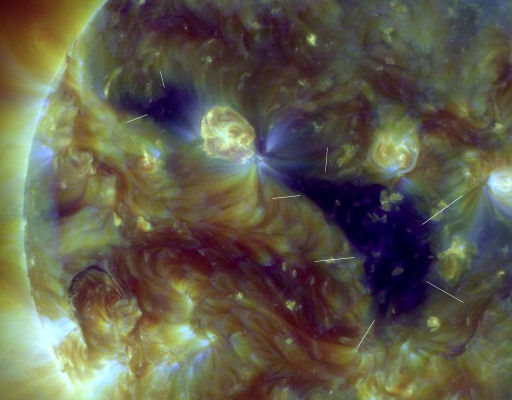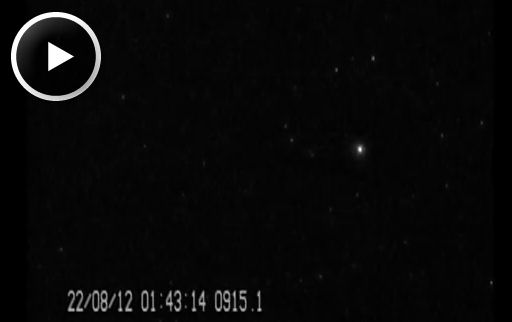QUIET SUN: With no strong flares for more than three days, the sun's x-ray output has nearly flatlined. Solar activity is low, and NOAA forecasters put the odds of an X-flare today at less than 1%. Solar flare alerts: text, phone.
CORONAL HOLE: A dark hole in the sun's atmosphere--a "coronal hole"--is turning toward Earth. NASA's Solar Dynamics Observatory captured this image of the gaseous chasm, which measures more than 200,000 km from end to end, during the early hours of August 23rd:
Coronal holes are places where the sun's magnetic field opens up and allows the underlying atmosphere to escape. A stream of solar wind flowing from this coronal hole should reach Earth on August 26-27. High-latitude sky watchers should be alert for auroras on that date. Aurora alerts: text, phone.
SATELLITE THROWN OVERBOARD: On August 20th, more than 400 km above Earth, Russian cosmonauts spacewalking outside the International Space Station threw a 20-pound metal sphere into orbit. Some reporters have likened the launch to a game of Lacrosse because of the Lacrosse-style basket station commander Gennady Padalka used to propel the satellite overboard.
Last night in Brockville, Ontario, veteran satellite watcher Kevin Fetter video-recorded the "Spherical Satellite" as it passed by the 2nd-magnitude star gamma Cygnus:
"It looked to be between mag 7 and 8--too dim for the naked eye but bright enough to see in binoculars," says Fetter.
The 21-inch-wide satellite will serve as a target in space that Russian scientists will use to test space tracking techniques for monitoring space junk and to study how it re-enters Earth's atmosphere. The ball is expected to stay in orbit for about three months before falling back to Earth.

![]()
Solar wind
speed: 415.9 km/sec
density: 0.4 protons/cm3
explanation | more data
Updated: Today at 1447 UT
![]()
X-ray Solar Flares
6-hr max: B1 1217 UT Aug23
24-hr: B3 0315 UT Aug23
explanation | more data
Updated: Today at: 1400 UT
![]()
![]()
![]()
Daily Sun: 23 Aug 12
![]()
![]()
A new sunspot is emerging at the circled location. Credit: SDO/HMI
![]()
![]()
![]()
Sunspot number: 65
What is the sunspot number?
Updated 23 Aug 2012
Spotless Days
Current Stretch: 0 days
2012 total: 0 days (0%)
2011 total: 2 days (<1%)
2010 total: 51 days (14%)
2009 total: 260 days (71%)
Since 2004: 821 days
Typical Solar Min: 486 days
Update 23 Aug 2012
The Radio Sun
10.7 cm flux: 95 sfu
explanation | more data
Updated 23 Aug 2012
![]()
![]()
![]()
Current Auroral Oval:
![]()
Switch to: Europe, USA, New Zealand, Antarctica
Credit: NOAA/POES
![]()
![]()
![]()
Planetary K-index
Now: Kp= 2 quiet
24-hr max: Kp= 3 quiet
explanation | more data
![]()
Interplanetary Mag. Field
Btotal: 6.3 nT
Bz: 2.6 nT south
explanation | more data
Updated: Today at 1447 UT
![]()
![]()
![]()
Coronal Holes: 23 Aug 12
![]()
![]()
A stream of solar wind flowing from the indicated coronal hole should reach Earth on Aug. 26-27. Credit: SDO/AIA.






